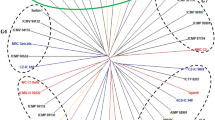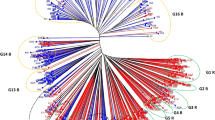Abstract
Broadening the genetic base of heterotic pools is a key to ensure continued genetic gains in hybrid breeding and extend hybrid cultivation to new areas. In the present study, two Central European heterotic pools (Carsten and Petkus) and five Eastern European open-pollinated varieties (OPVs, Pop-1 to Pop-5) were studied with the objectives to (1) investigate the genetic diversity in OPVs and the heterotic pools using molecular and field data, (2) evaluate the molecular diversity among OPVs, (3) examine the combining ability for grain yield of the OPVs when crossed with testers in field trials, and (4) develop a strategy for targeted introgression of OPV germplasm into the heterotic pools. In total, 610 S0 plants, 347 from OPVs and 263 from heterotic pools, were developed. Clones of the S0 plants of OPVs were crossed with two testers belonging to each heterotic pool, while clones of heterotic pools were crossed with only the opposite tester. Testcrosses were evaluated for grain yield in multi-location trials. In addition, 589 S0 plants were fingerprinted with 30 SSR markers. The data revealed that the Carsten pool has a narrow genetic base and should be the primary target for broadening the established heterotic pattern. Mean and genetic variance suggested that Pop-2 and Pop-4 are good candidates for introgression in Petkus pool and Pop-5 in Carsten pool. Nevertheless, introgression of Pop-5 in Carsten could reduce the genetic diversity between heterotic pools. Therefore, we suggest that either selected plants of Pop-5 should be introgressed or more Eastern European germplasm should be fingerprinted and field evaluated to identify promising germplasm for broadening the established heterotic pattern.



Similar content being viewed by others
References
Duvick DN, Smith JSC, Cooper M (2004) Long-term selection in a commercial hybrid maize breeding program. Plant Breed Rev 24:109–151
Evanno G, Regnaut S, Goudet J (2005) Detecting the number of clusters of individuals using the software STRUCTURE: a simulation study. Mol Ecol 14:2611–2620
Falconer DS, Mackay TFC (1996) Introduction to quantitative genetics, 4th edn. Longman Group Ltd, London, UK
Geiger HH, Miedaner T (1999) Hybrid rye and heterosis. In: Coors JG, Pandey S (eds) Genetics and exploitation of heterosis in crops. CSSA, Madison, WI, USA, pp 439–450
Gilmour AR, Gogel BJ, Cullis BR, Welham SJ, Thompson R (2002) ASReml user guide. Release 1.0. VSN International, Hemel Hempstead
Gower JC (1966) Some distance properties of latent root and vector methods used in multivariate analysis. Biometrika 53:325–338
Hackauf B, Wehling P (2002) Identification of microsatellite polymorphisms in an expressed portion of the rye genome. Plant Breed 121:17–25
Hackauf B, Wehling P (2003) Development of microsatellite markers in rye: map construction. Plant Breed Seed Sci 48:143–151
Hepting L (1978) Analyse eines 7x7–Sortendiallels zur Ermittlung geeigneten Ausgangsmaterials für die Hybridzüchtung bei Roggen. Z Pflanzenzüchtung 80:188–197
Khlestkina EK, Than MHM, Pestsova EG, Roder MS, Malyshev SV, Korzun V, Borner A (2004) Mapping of 99 new microsatellite derived loci in rye (Secale cereale L.) including 39 expressed sequence tags. Theor Appl Genet 109:725–732
Khlestkina EK, Than MHM, Pestsova EG, Roder MS, Malyshev SV, Korzun V, Borner A (2005) Erratum: mapping of 99 new microsatellite derived loci in rye (Secale cereale L.) including 39 expressed sequence tags. Theor Appl Genet 110:990–991
Liu K (2002) PowerMarker: a powerful software for marker data analysis. http://www.powermarker.net
Lundqvist A (1956) Self-incompatibility in rye. I. Genetic control in the diploid. Hereditas 42:293–348
Lynch M, Walsh B (1997) Genetics and analysis of quantitative traits. Sinauer Associates, Sunderland, MA, USA
Maurer HP, Melchinger AE, Frisch M (2008) Population genetic simulation and data analysis with Plabsoft. Euphytica 161:133–139
Melchinger AE (1999) Genetic diversity and heterosis. In: Coors JG, Pandey S (eds) The genetics and exploitation of heterosis in crops. CSSA, Madison, WI, USA, pp 99–118
Melchinger AE, Gumber RK (1998) Overview of heterosis and heterotic groups in agronomic crops. In: Lamkey KR, Staub JE (eds) Concepts and breeding of heterosis in crop plants. CSSA, Madison, WI, USA, pp 29–44
Melchinger AE, Utz HF, Schön CC (1998) Quantitative trait locus (QTL) mapping using different testers and independent population samples in maize reveals low power of QTL detection and large bias in estimates of QTL effects. Genetics 149:383–403
Miedaner T (1997) Roggen: Vom Unkraut zur Volksnahrung. DLG Verlag, Frankfurt/Main, Germany
Nei M (1987) Molecular evolutionary genetics. Columbia University Press, New York, USA
Patterson HP (1997) Analysis of series of variety trials. In: Kempton RA, Fox PN (eds) Statistical methods for plant variety evaluation. Chapman and Hall, London, UK, pp 139–161
Piepho H-P (2004) An algorithm for a letter-based representation of all-pairwise comparisons. J Comput Graph Statist 13:456–466
Piepho H-P, Möhring J (2007) Computing heritability and selection response from unbalanced plant breeding trials. Genetics 177:1881–1888
Piepho H-P, Williams ER, Fleck M (2006) A note on the analysis of designed experiments with complex treatment structure. HortScience 41:446–452
Pritchard JK, Stephens M, Donnelly P (2000) Inference of population structure using multilocus genotype data. Genetics 155:945–959
Reif JC, Melchinger AE, Xia XC, Warburton ML, Hoisington DA, Vasal SK, Beck D, Bohn M, Frisch M (2003) Use of SSRs for establishing heterotic groups in subtropical maize. Theor Appl Genet 107:947–957
Reif JC, Hamrit S, Heckenberger M, Schipprack W, Maurer HP, Bohn M, Melchinger AE (2005) Genetic structure and diversity of European flint maize populations determined with SSR analyses of individuals and bulks. Theor Appl Genet 111:906–913
Reif JC, Gumpert FM, Fischer S, Melchinger AE (2007) Impact of interpopulation divergence on additive and dominance variance in hybrid populations. Genetics 176:1931–1934
SAS Institute (1999) The SAS system for windows. Release 8.02. SAS Institute, Cary, NC, USA
Schnell FW (1965) Die Covarianz zwischen Verwandten in einer gen-orthogonalen Population. I. Allgemeine Theorie. Biometrische Zeitschrift 7:1–49
Schnell FW (1983) Probleme der Elternwahl - ein Überblick. In: Ber Arbeitstagg 1983 Arbeitsgem Saatzuchtleiter. Gumpenstein, Austria, pp 1–11
Smith JCS, Duvick DN, Smith OS, Cooper M, Feng L (2004) Changes in pedigree backgrounds of Pioneer brand maize hybrids widely grown from 1930 to 1999. Crop Sci 44:1935–1946
Stich B, Möhring J, Piepho H-P, Heckenberger M, Buckler ES, Melchinger AE (2008) Comparison of mixed-model approaches for association mapping. Genetics 178:1745–1754
Stram DO, Lee JW (1994) Variance components testing in the longitudinal mixed effects model. Biometrics 50:1171–1177
Wilde P, Korzun V, Schmiedchen B, Goncharenko AA, Torop AA (2006) Genetic diversity within and among middle- and East European rye populations determined by phenotypic and SSR marker data. Proceedings of the Eucarpia Rye Meeting, June 28–30, Groß Lüsewitz, Germany
Wright S (1978) Evolution and genetics of populations, vol IV. The University of Chicago Press, Chicago, USA
Acknowledgments
This project was supported by the German Research Foundation DFG in the framework program “Heterosis in plants” (research grants No 2254/1-1 and 2254/1-2 and Pi 377/7-3) and Bundesministerium für Bildung und Forschung in the “Biometrie und Bioinformatik Tools für die genomisch gestützte Pflanzenzüchtung” (GAIN) project of the Genome Analysis of the Plant Biological System (GABI) initiative (http://www.gabi.de).
Author information
Authors and Affiliations
Corresponding author
Additional information
Communicated by F. Ordon.
Contribution to the special issue “Heterosis in Plants”.
Electronic supplementary material
Below is the link to the electronic supplementary material.
Rights and permissions
About this article
Cite this article
Fischer, S., Melchinger, A.E., Korzun, V. et al. Molecular marker assisted broadening of the Central European heterotic groups in rye with Eastern European germplasm. Theor Appl Genet 120, 291–299 (2010). https://doi.org/10.1007/s00122-009-1124-0
Received:
Accepted:
Published:
Issue Date:
DOI: https://doi.org/10.1007/s00122-009-1124-0




